- Servlet(Server Applet):全称Java Servlet。是用Java编写的服务器端程序。其主要功能在于交互式地浏览和修改数据,生成动态Web内容。
- 狭义的Servlet是指 Java语言实现的一个接口,广义的Servlet是指任何实现了这个Servlet接口的类。
- HttpServlet: 指能够处理 HTTP 请求的 servlet,它在原有 Servlet 接口上添加了一些与 HTTP 协议处理方法,它比 Servlet 接口的功能更为强大。因此开发人员在编写Servlet时,通常应继承这个类,而避免直接去实现Servlet接口。
- HttpServlet 在实现 Servlet 接口时,覆写了 service 方法,该方法体内的代码会自动判断用户的请求方式,如为 GET 请求,则调用 HttpServlet 的 doGet 方法,如为 Post 请求,则调用 doPost 方法。因此,开发人员在编写 Servlet 时,通常只需要覆写 doGet 或 doPost 方法,而不要去覆写 service 方法。
参考:https://blog.csdn.net/HeatDeath/article/details/79057168
转:https://blog.csdn.net/m0_38039437/article/details/75264012
一、HttpServlet简介
1、HttpServlet是GenericServlet的子类,又是在GenericServlet的基础上做了增强。
2、HttpServlet方法
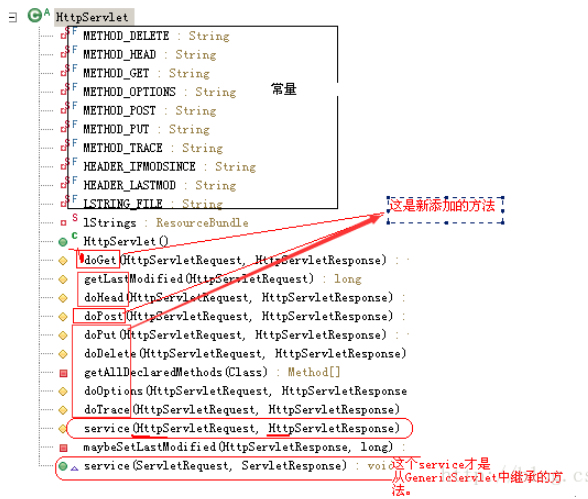
二、HTTP实现doGet或doPost请求项目介绍
1、通过实现doGet请求和doPost请求实例来了解内部的工作原理。
2、doGet请求和doPost请求实例代码介绍:
A:创建一个Servlet类继承HttpServlet类
B:在index.jsp页面创建一个超链接请求
3、doGet请求和doPost请求实例实施介绍:
A、创建一个webproject项目。

B、创建一个Servlet类的名称为HttpServ继承HttpServlet类同时覆写doGet方法和doPost方法。
1、
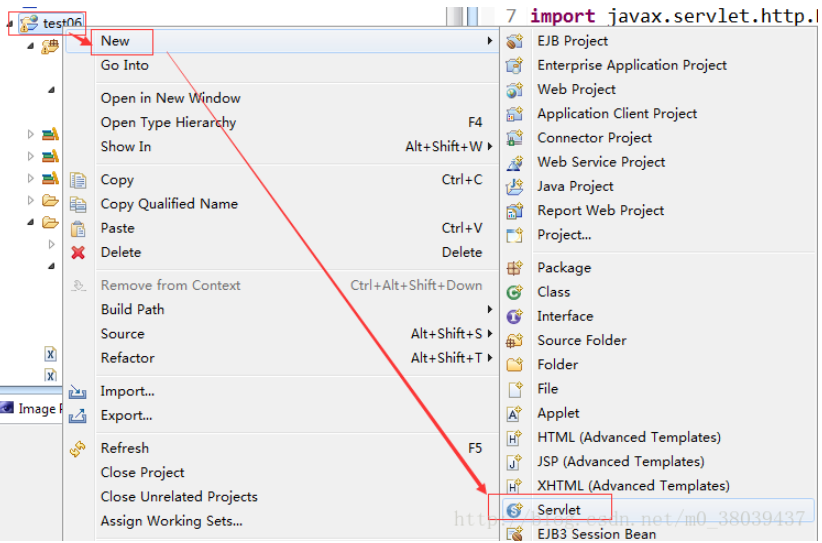
2、
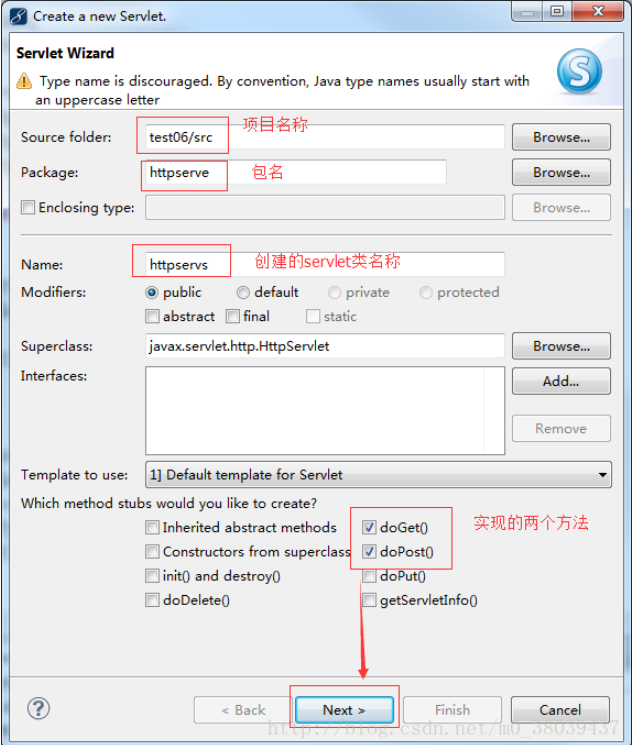
3、配置web.xml文件
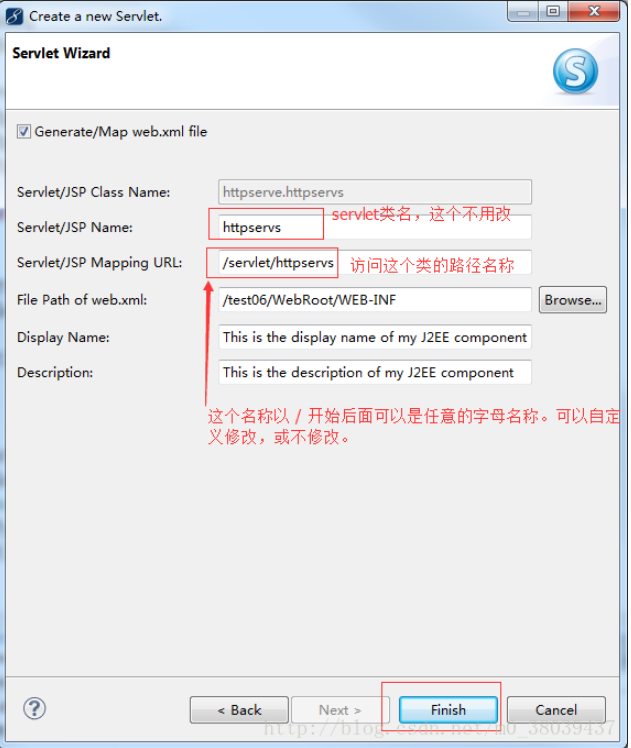
4、创建Servlet代码展示
package httpserve;
import java.io.IOException;
import java.io.PrintWriter;
import javax.servlet.ServletException;
import javax.servlet.http.HttpServlet;
import javax.servlet.http.HttpServletRequest;
import javax.servlet.http.HttpServletResponse;
public class HttpServ extends HttpServlet {
public void doGet(HttpServletRequest request, HttpServletResponse response)
throws ServletException, IOException {
System.out.println("发送get请求。。。。。。。。。。。");
}
protected void doPost(HttpServletRequest req, HttpServletResponse resp)
throws ServletException, IOException {
// TODO Auto-generated method stub
resp.setContentType("text/html;charset=UTF-8");
System.out.println("发送post方法。。。。。。。。。。");
}
5、web.xml配置文件代码展示
<?xml version="1.0" encoding="UTF-8"?>
<web-app version="3.0"
xmlns="http://java.sun.com/xml/ns/javaee"
xmlns:xsi="http://www.w3.org/2001/XMLSchema-instance"
xsi:schemaLocation="http://java.sun.com/xml/ns/javaee http://java.sun.com/xml/ns/javaee/web-app_3_0.xsd">
<servlet>
<description>This is the description of my J2EE component</description>
<display-name>This is the display name of my J2EE component</display-name>
<servlet-name>HttpServ</servlet-name>
<servlet-class>httpserve.HttpServ</servlet-class>
</servlet>
<servlet-mapping>
<servlet-name>HttpServ</servlet-name>
<url-pattern>/http</url-pattern>
</servlet-mapping>
</web-app>
C、在index.jsp页面创建一个超链接请求
<%@ page language="java" import="java.util.*" pageEncoding="UTF-8"%>
<%
String path = request.getContextPath();
String basePath = request.getScheme()+"://"+request.getServerName()+":"+request.getServerPort()+path+"/";
%>
<!DOCTYPE HTML PUBLIC "-//W3C//DTD HTML 4.01 Transitional//EN">
<html>
<head>
<base href="<%=basePath%>">
<title>My JSP 'index.jsp' starting page</title>
<meta http-equiv="pragma" content="no-cache">
<meta http-equiv="cache-control" content="no-cache">
<meta http-equiv="expires" content="0">
<meta http-equiv="keywords" content="keyword1,keyword2,keyword3">
<meta http-equiv="description" content="This is my page">
<!--
<link rel="stylesheet" type="text/css" href="styles.css">
-->
</head>
<body>
This is my JSP page. <br>
<a href="http://localhost:8080/test06/http">get请求1</a><br/>
<!-- 对于一个html页面来说,如果没有以http开始,则默认的前面会加上
协议类型://目前这个页面所在的服务器:目前端口/目前项目/你给的这个名称 -->
<a href="http">get请求2</a><hr/>
<form method = "post" action="http">
<input type="submit" value="提交"/>
</form>
</body>
</html>
D、发送doGet请求和doPost请求
a、在浏览器中输入测试地址,http://127.0.0.1:8080/test06/
b、打开项目的首页后分别点击get请求1、get请求2、和 post请求(提交按钮)
c、在控制台可以观察到分别调用了doGet和doPost方法。
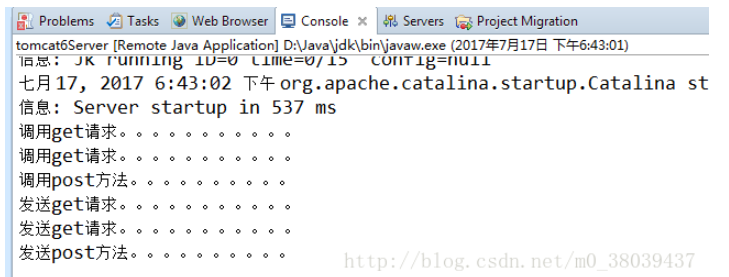
三、HTTP实现doGet或doPost请求原理介绍
1、浏览器发送请求到HttpSevr类调用HttpServ的service(servletRequest, servletReponse)方法
2、由于没有找到这个方法,去调用父类(HttpServlet) 的同名方法。
3、父类的service方法将ServletRequest req请求转换成HttpServletRequest请求,再去调用service(request, response) 方法。
将ServletRequest req请求转换成HttpServletRequest请求再调用service(request, response) 方法源码如下:
public void service(ServletRequest req, ServletResponse res)
throws ServletException, IOException {
HttpServletRequest request;
HttpServletResponse response;
try {
request = (HttpServletRequest) req;
response = (HttpServletResponse) res;
} catch (ClassCastException e) {
throw new ServletException("non-HTTP request or response");
}
service(request, response);
}
4、 调用的service(request, response) 方法功能是判断用户发出是什么请求,如果是get则调用子类(HttpSevr)的doGet方法,如果是post则调用子类(HttpSevr)的doPost方法。
service(request, response) 方法源码如下:
protected void service(HttpServletRequest req, HttpServletResponse resp)
throws ServletException, IOException {
String method = req.getMethod();
if (method.equals(METHOD_GET)) {
long lastModified = getLastModified(req);
if (lastModified == -1) {
// servlet doesn't support if-modified-since, no reason
// to go through further expensive logic
doGet(req, resp);
} else {
long ifModifiedSince;
try {
ifModifiedSince = req.getDateHeader(HEADER_IFMODSINCE);
} catch (IllegalArgumentException iae) {
// Invalid date header - proceed as if none was set
ifModifiedSince = -1;
}
if (ifModifiedSince < (lastModified / 1000 * 1000)) {
// If the servlet mod time is later, call doGet()
// Round down to the nearest second for a proper compare
// A ifModifiedSince of -1 will always be less
maybeSetLastModified(resp, lastModified);
doGet(req, resp);
} else {
resp.setStatus(HttpServletResponse.SC_NOT_MODIFIED);
}
}
} else if (method.equals(METHOD_HEAD)) {
long lastModified = getLastModified(req);
maybeSetLastModified(resp, lastModified);
doHead(req, resp);
} else if (method.equals(METHOD_POST)) {
doPost(req, resp);
} else if (method.equals(METHOD_PUT)) {
doPut(req, resp);
} else if (method.equals(METHOD_DELETE)) {
doDelete(req, resp);
} else if (method.equals(METHOD_OPTIONS)) {
doOptions(req,resp);
} else if (method.equals(METHOD_TRACE)) {
doTrace(req,resp);
} else {
//
// Note that this means NO servlet supports whatever
// method was requested, anywhere on this server.
//
String errMsg = lStrings.getString("http.method_not_implemented");
Object[] errArgs = new Object[1];
errArgs[0] = method;
errMsg = MessageFormat.format(errMsg, errArgs);
resp.sendError(HttpServletResponse.SC_NOT_IMPLEMENTED, errMsg);
}
}
5、调用关系图
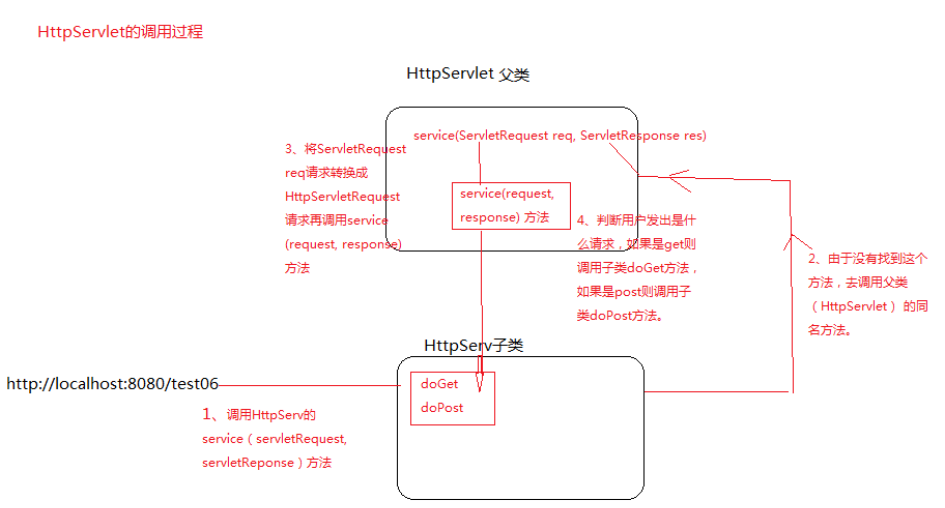
四、注意事项:
1、如果在HttpServ中覆盖了service(ServletRequest,SerlvetResonse)方法则这个类的所实现的doGet/doPost都不会再执行了。
因为service(ServletRequest,SerlvetResonse)是最高接口Servlet定义规范。在tomcat调用时,一定会在最终的子类中去找这个方法且调用它。
如果最终的子类没有则会调用父的service(ServletRequest,SerlvetResonse)。
2、如果覆盖了serivce(HttpServletRequest,HtpServletResponse)则会执行httpServlet中的service(ServletRequest,SerlvetResonse),但是由于子类中已经覆盖了serivce(HttpServletRequest,HtpServletResponset)所以,httpServlet中的serivce(HttpServletRequest,HtpServletResponset)就不再执行了,而是直接执行子类中同名同参数方法,且doXxxx也不会执行了,因为子类的serivce(HttpServletRequest,HtpServletResponset)没有调用doXxxx.
3、如果继承了HttpServlet没有实现任何的doXxx方法则会抛出一个异常
五:客户端请求和返回数据用到的常用方法 https://www.cnblogs.com/xdp-gacl/p/3798347.html
